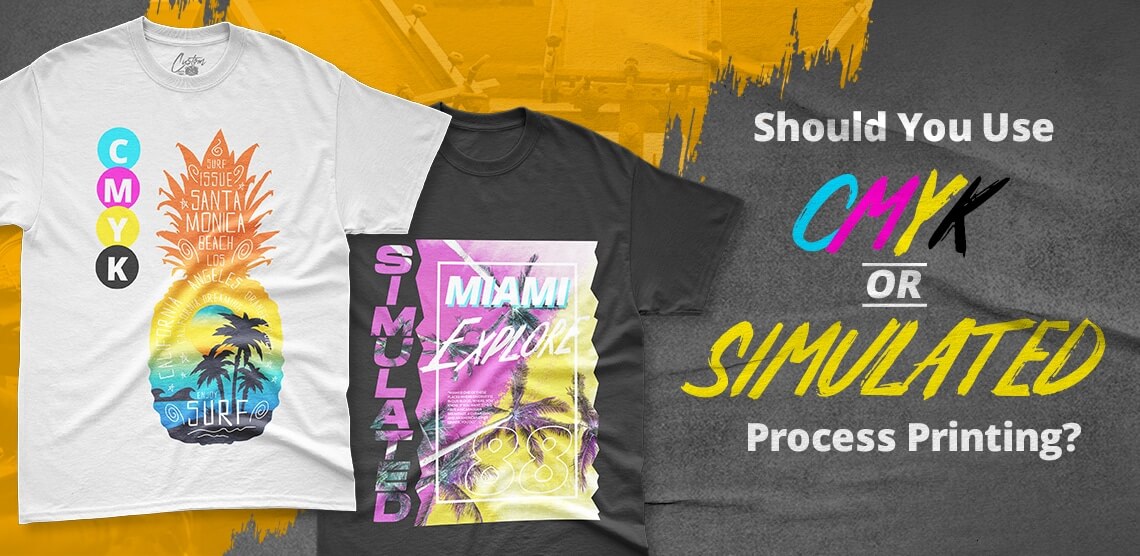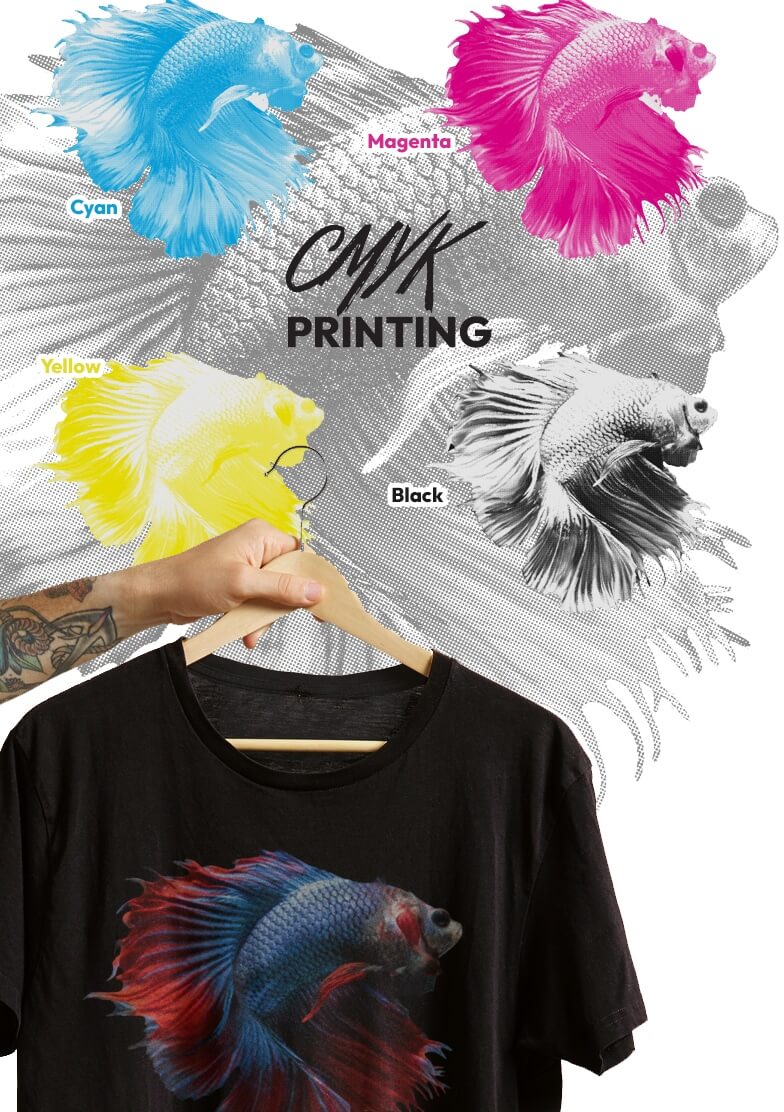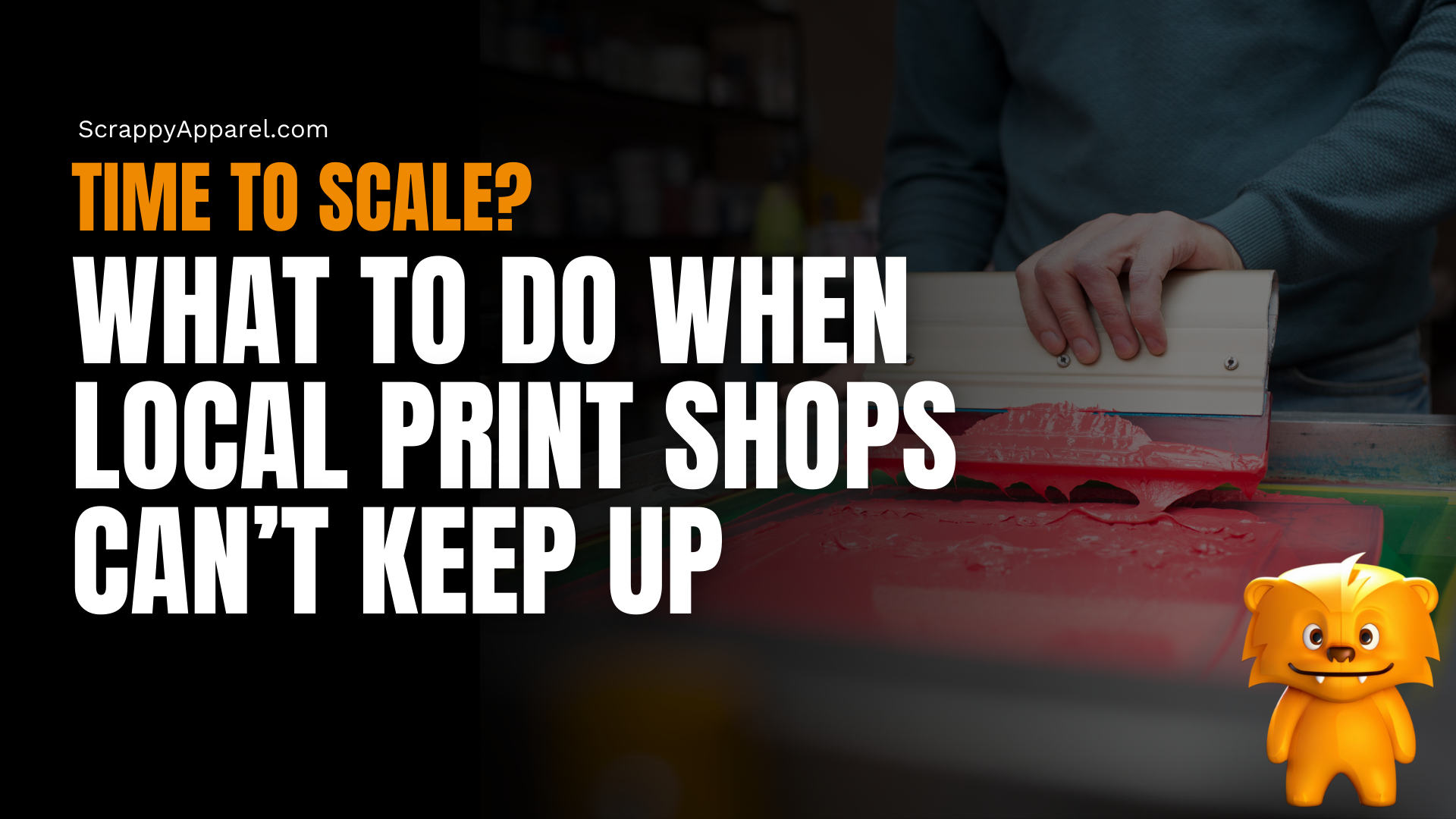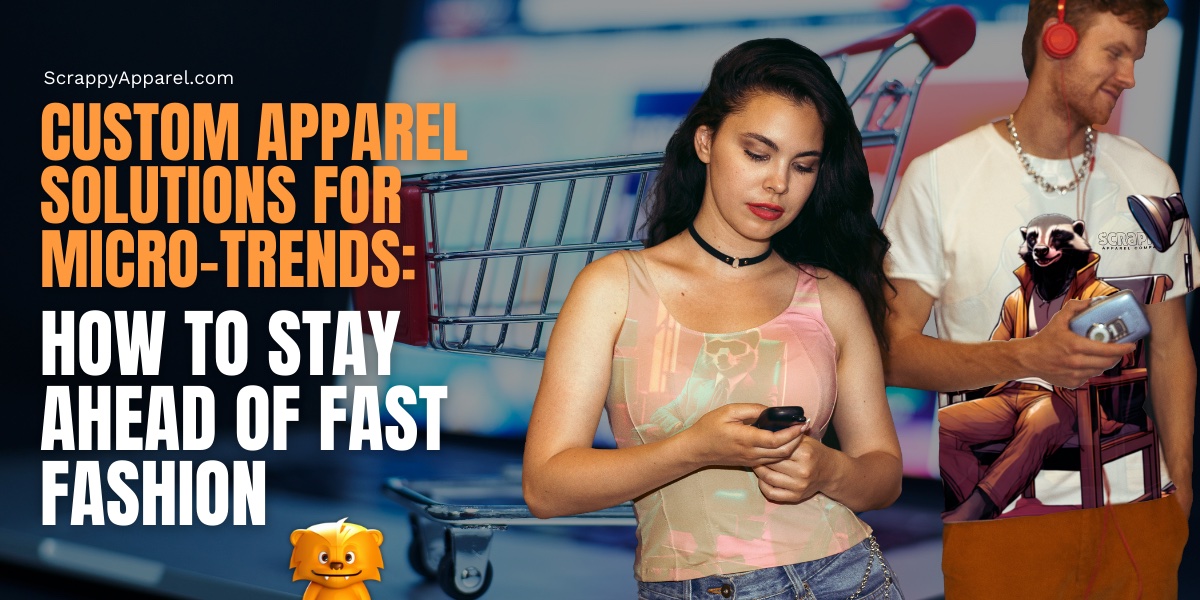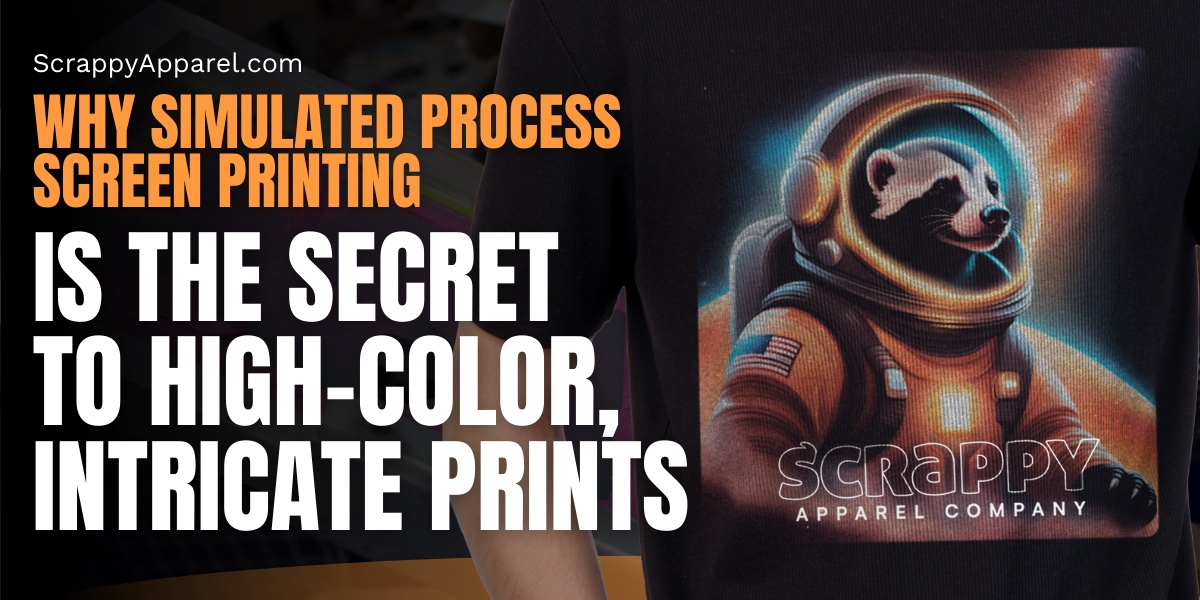Should You Use CMYK or Simulated Process Printing?
If you want to learn how to get custom apparel that is vibrant, durable, and soft-to-the-touch, you’re in the right place—the Scrappy Apparel website, of course. We’re about to dive deep into two of the most common approaches to printing: CMYK and simulated process.
You only get the best when you work with the best. (Wink wink.) But for real, we prioritize quality above all, and that means choosing a printing process that will yield the best results.
CMYK and simulated process printing are two commonly used approaches. We’re going to discuss the pros and cons and ins and outs of these two popular printing processes.
Once you’ve become a full-on expert on both printing processes, you can make an educated guess on which one will fit your needs better.
Spoiler alert: both work, but one process is going to offer you a much better print overall.
What is CMYK printing?
CMYK sounds pretty familiar, doesn’t it?
Let’s jog your memory. Have you ever had to buy the color cartridge for your printer at home and the cartridge box shows three colors: blue, pink, and yellow? That’s CMYK.
CMYK stands for cyan, magenta, yellow, and key (black)—the four colors of ink used in traditional color printing.
These four colors make up the basis for almost all color printing. That’s because it uses a subtractive color model, meaning that the colors are combined to create the hues you see on paper.
The same is true for custom apparel. The colors are combined—or overlaid on top of one another—to create the final design. The fabric absorbs the ink, which is then cured with heat to set the design, and your garment is good to go.
The pros and cons of CMYK printing
Now that we’re all aware of what CMYK means and how it works, let’s get down to the pros and cons of using this color printing process.
You’d think this popular printing process would have more pros, but that’s not always the case. Here are some factors to consider before you decide whether CMYK is right for your custom apparel:
Pros of CMYK
- It can be cost-effective.
- It produces a smooth printed image.
- This printing process can be used with multiple types of inks.
Cons of CMYK
- The image might not look precise when you take a very close look.
- A very detailed image won’t look its best once printed.
- Some colors can’t be printed correctly.
Ultimately, CMYK is a decent choice, but it probably isn’t ideal for complex images with tons of colors.
What is simulated process printing?
No, we aren’t living in a simulation. Well, at least we hope not. But we’re definitely living for simulated process printing.
Simulated process printing is a technique in which you can create many colors from just a few screens. Instead of producing only one color per screen, simulated process printing utilizes halftones and gradients to offer a wider range of colors on the finished print.
Simulated process screen printing is a great way to create custom apparel because it allows for any design or image to be printed onto the fabric. This printing process is also very versatile, and it can be used on a variety of different fabrics.
Personally, we think this is a perfect choice for anyone looking for top-of-the-line, precise prints. With its many advantages, it’s no wonder that simulated process printing is becoming more popular.
The pros and cons of simulated process printing
To make this a fair comparison to CMYK, we must show you the advantages and disadvantages of choosing simulated process printing. Let’s take a look:
Pros of simulated process printing
- It’s great for photorealistic designs.
- It works well for designs that require more than one or two colors.
- It’s more accurate, so your prints will be sharper and more precise.
- It’s less likely to smudge or fade over time.
Cons of simulated process printing
- It requires more education and experience to perfect.
- It’s generally more expensive than traditional printing techniques.
You can probably already assume which printing process we prefer at Scrappy—but again, we wanted to show you both options so you can make an informed decision.
How halftoning works in CMYK vs. simulated process printing
We’ve talked a lot about CMYK and simulated process printing, but how do these two printing processes differ when it comes to halftoning?
Halftoning is a process that combines dots of varying sizes to create a gradient effect. This is used for images or designs with a lot of colors because it makes the color transitions appear smoother.
The way halftoning works is actually pretty interesting. When an image is printed using halftoning, the design is first separated into four colors: cyan, magenta, yellow, and black. These colors are then printed using dots of varying sizes.
The sizes of the dots depend on how light or dark the color is supposed to be. For example, if a color is supposed to be printed as a light shade, the dots will be small. If the color is supposed to be printed as a dark shade, the dots will be large.
This printing technique is used in both CMYK and simulated process printing. However, there are some key differences between the two. In CMYK printing, the dots are usually of equal size. This means that all four colors are printed using the same-sized dots.
On the other hand, in simulated process printing, each color is printed using dots of different sizes. This allows for a more accurate print and smoother color transitions.
CMYK vs. simulated process printing: Who wins this knockout round?
In a tough fight against the well-known CMYK and the newer simulated process printing, it’s safe to say that for custom apparel with detail and color, simulated process printing wins by knockout.
At Scrappy Apparel, we want to ensure your designs get all the best detail and the brightest colors we can possibly create because, at the end of the day, we want your graphics to look absolutely killer from every angle—from afar, up close, and even upside down.
Now, let’s say you’ve decided you want to go ahead and get your apparel printed with simulated process printing. How will you prepare your artwork?
Artwork prep tips for the perfect print
When you’re creating your artwork for simulated process printing, there are a few things you’ll need to consider:
1. Create your graphics with certain limitations in mind.
A few examples of details you might have that may not print precisely are drop shadows, gradients, and glows. This is not meant to limit your creativity. We want to make sure your creative juices are flowing at 100%. But we also want to make your creativity translates well onto your custom apparel.
2. Convert your artwork into a vector file.
We recommend designing your graphics in Adobe Illustrator because it’s the best program to use if you want to create vector files. When you’re ready to save, make sure you choose .EPS or .AI as your file extension so your design is saved in a vector format.
3. Use color theory best practices.
Use contrast to make your design pop. You can do this by using light colors on a dark background or vice versa.
4. Keep your budget in mind.
Some colors, such as metallics, will be heavier on your wallet. If you’re looking to save some money, consider using a less expensive color palette.
5. Format your design in the right color mode for printing.
When it comes to colors, you need to set your color mode. Although CMYK is a color mode option, we recommend setting your color mode to Pantone. This mode is best for precise color matches.
6. Expand your strokes.
Before completing your graphic, please expand your strokes. This ensures that your design will be printed correctly and there won’t be any white gaps around the edges of your lines.
If you enjoyed these tips, we have good news—there’s more!
Download our free artwork preparation guide to learn everything you need to know to get your artwork print-ready. This guide covers topics such as file types, color modes, bleed, and more!
Scrappy Apparel vs. DIY printing
In an era when TikTokers are dyeing clothes with buckets of water and printing graphics onto old t-shirts left and right, you might fall into the temptation to create your own custom apparel.
Now, we aren’t saying that we don’t have faith in you—we just have a loooooot more faith in ourselves. With 16 years of experience in the custom apparel world, we’ve pretty much seen and done it all when it comes to custom apparel. So, we’re confident that we can help you create the exact design you have in mind.
Now, maybe you’re asking, “What can possibly go wrong with making my own custom apparel at home?” Well, here are a few things to keep in mind:
1. You might not have all the necessary materials.
You’ll need more than just a design. You’ll need fabric, ink… you get the idea. If you don’t have all of the right materials, your design will not turn out the way you want it to.
2. The quality will not be as good as if you left it to the professionals.
When you print your own graphics onto apparel, the quality will not be as good as it would be if you used a professional printing company. The colors might not be as vibrant and the design might not last as long.
3. It takes time to create custom apparel—a lot of time.
Creating custom apparel is a process. You can’t just print your graphics onto a t-shirt and call it a day. In fact, the process can take hours—and that’s if you know what you’re doing.
Now, since we’ve already established what a complicated and extensive process custom printing your apparel can be, imagine when you’re ready to scale your brand.
Sure, you can probably make one or two shirts, but what about when you need to make 10, 100, or 1,000? You’ll quickly realize that you’re in over your head and that’s when you’ll come to us.
4. You’ll need the right machinery.
Ah, machines. Yes, we have those. The best kinds, actually. That’s why it’s even better to work with us instead of doing it yourself.
Are you interested in printing a detailed graphic? We have machines for that.
Want to blow up your design into a jumbo size? We have machines for that.
Searching for a company that can get 100 shirts for the whole team created with ease? You guessed it, we have machines for that.
5. You might not get the results you want.
There’s a reason why we’ve been in the custom apparel business for 16 years—because we know what we’re doing. We have the experience and the expertise to help you create the perfect design for your custom apparel. DIY-ing your custom apparel might save you some money in the short term, but it could cost you in the long run if you’re not happy with the results.
6. When you work with us, you get to leverage the experience of brand-building experts.
We don’t just print custom apparel—we help our customers build their brands. When you work with us, you get access to our team of brand-building experts who can help you scale your custom apparel brand to infinity and beyond.
We want to see you succeed, and we’ll do whatever it takes to help you get there. So, if you’re looking for someone to partner with on your custom apparel journey, look no further than Scrappy Apparel.
For a little extra convincing, we’d like to mention that we ship all of your custom apparel for free straight to your doorstep. We meet every single deadline. No excuses, just results.
Ready to begin your simulated process printing project?
Go ahead and click below to get your free estimate. Trust us, we are worth it.
